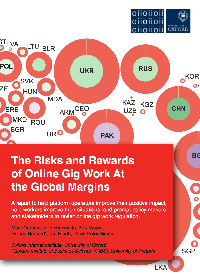
Executive Talent Magazine
What is the Gig economy?
With a name appropriated from performance culture where musicians play a limited engagement, or a “gig,” the gig economy describes the expanding labor market comprised of contract workers, freelancers, crowdsourced workers, and others who are hired for limited engagements, as well as platform-based systems—think ride sharing, delivery, and property rentals. Independent work is growing with the internet, and expanding from developed to developing economies as more of the world becomes digitally connected.
“The historical notion of an employee is no longer viable, and it is imperative to learn the new rules that govern the overwhelming number of workers joining the gig economy. We knew what drove employees when they were within our four walls, but now we have to learn how to manage them spread across cities, countries, and even the globe.”
– Stowe Boyd, “Swift Trust in the Gig Economy”, WorkFutures.com, February 2018
“Where giggers were once responding to market conditions, they are now creating the conditions, disrupting the traditional workforce as we know it.”
– Korn Ferry Institute
Many workers who engage in the gig economy choose independent work, and others do so out of necessity. Organizations that employ independent workers are finding the gig economy a valuable resource for addressing short-term needs and filling temporary skills gaps in their organizations.
“Open-talent economy, alternative workforce, gig economy, internet organized workforce, sharing economy and liquid workforce are all terms that define the market of workers who supply organizations with on-demand talent,” Eileen Finn, president and founder of Eileen Finn & Associates in New York, explains.
Paul Surridge leads Signium’s UK Leadership Consulting Practice. He says “Organizations need to acquire specific skill sets for a specific period of time. Often, it’s too hard to figure out what roles organizations will need in the future, but what they can do is acquire those skills and capabilities on demand, on the open talent market. A lot more industries are looking to that model.”
Hansjörg Meine, managing partner for AltoPartners in Darmstadt, worked for over two decades at IBM with responsibilities that included outsourcing. “We had a mixture of people both inside IBM and people outside the company, helping to extend our workbench. This is the first step to this contingent work style which we now see coming more down the road,” he says.
“Approximately 150 million workers in North America and Western Europe have left the relatively stable confines of organizational life—sometimes by choice, sometimes not—to work as independent contractors. Some of this growth reflects the emergence of ride-hailing and task-oriented service platforms, but a recent report by McKinsey found that knowledge-intensive industries and creative occupations are the largest and fastest-growing segments of the freelance economy.”
– “Thriving in the Gig Economy”, Gianpiero Petriglieri, Susan J. Ashford, and Amy Wrzesniewski, Harvard Business Review, March-April 2018
Workers in the gig economy can be one-of-a-kind experts, or one-in-a-thousand; at the top of their professions, or just starting out. Finn describes “a person developing strategy for my Fortune 50 client, a very senior HR professional.”
Meine shares the example of a company developing new software that needs testing. He says, “For this kind of project, companies build a fullycrowded testing environment so you have a handful of employees and a couple thousand people crowd testing the software. You discover what is good, what is bad, what is not working—and it only takes a few hours because you are distributing it through thousands of people.”
Technology has enabled global freelancing for individuals, and online platforms allow for the buyers and sellers of contract work to find each other.
Finn says, “The majority of people in this gig economy are people who execute, who are subject matter experts, and perhaps are a bit more tactical in the work that they do.”
Organizations are trending toward a greater reliance on the gig economy. According to The Conference Board’s “C-Suite ChallengeTM 2018,” of CHROs surveyed worldwide, only 41% agreed that their workforce would be “predominantly comprised of traditional, full-time employees” and more than 79% agreed that the “percentage of directly hired contingent workers and freelancers will increase.”
The economics of the gig economy are fairly straight-forward. Contingent workers generally are paid per piece, per project, or per hour. “For an expense perspective—these individuals are not paid an hourly rate, they are usually paid a bit higher, but they don’t receive benefits that a permanent full-time hire would receive such as cash bonus, equity, long-term incentive plan, paid vacation or personal time off, or health benefits. So the cost to the employer is much less,” Finn says.
And while hiring contingent workers is generally more cost-efficient than FTE salary and benefits, cost cutting is not the main driver of the gig economy. “Hiring contingent workers is not necessarily driven by reducing costs, and it’s not necessarily driven by the changing demands of young people entering the workforce. I think it stems from the fact that there is a lack of talent and skills in the marketplace that organizations need today, and because change is happening quickly, they’re not able to define their longterm needs. The gig economy helps organizations meet their immediate needs.”
Chandrika Pasricha, founder and chief executive officer of Flexing It, a platform for independent consultants in India and South-East Asia says, “Our Future Of Work survey tells us that Indian knowledge professionals are increasingly opting for independent gigs as a matter of choice and are seeking flexibility and purpose in their career.” (from “Is India ready to embrace the gig economy?” livemint. com, February 11, 2018).
Gig work allows for a measure of independence that many people enjoy. According to PwC’s “Workforce Of The Future Report,” the “desire for autonomy is strongest in China, especially among young people, indicating a generational shift in attitude towards greater freedom, entrepreneurship and specialist skills in this rapidly evolving economy.”
 Managing in the gig economy
Managing in the gig economy
“When companies started to think about outsourcing or out tasking their work to offshore software development companies, everyone thought this was a fantastic opportunity: there are thousands of well-educated software developers in India,” Meine says.
However, managing complex, offsite projects can be complicated. Meine explains, “You have to think, how do you package this? A lot of companies learned this the hard way— you must have the local contact, local knowledge, and an understanding of the local culture to make sure client and contractor understand each other.”
For example, Meine says, “In my own experience, we outsourced a project and wrote everything down, but using the same words doesn’t necessarily convey the same meaning. There was a complete disconnect between what we needed to have, and what they understood and delivered. The lesson here is you need to have very tight links between your external workforce and internal workforce. If you don’t, things can develop in different directions.”
The contingent workforce is also an important consideration within workforce planning. Surridge sees “an opportunity for CHROs to get ahead of the curve and redesign their organizations for the future. One thing everyone is fairly confident of is that roles in the future will be different. We are going to have a blended workforce.”
Agile businesses increasingly turn to external talent when they can’t find the competencies they need in the traditional marketplace, and managing relationships with talent not bound to the organization is highstakes. “The war for talent is a war for skills that are in real shortage,” Surridge says. “Those organizations that struggle to connect and engage with the contingent workforce will find them more scarce.”
For example, Finn describes “someone working in a company for someone who they may not like, may decide to put up with it because the benefits are great, they’ve been there for a number of years, they are invested. A contractor who works for a person they don’t care for can choose to make a change. And especially because if they are building a consulting resume it doesn’t matter how long you are in that role. They can say ‘I was brought in for three months’ and that’s it—no questions asked. A permanent person is going to wonder what quitting is going to do to their resume—that’s the difference.”
People working in the gig economy have the freedom to choose when and how they are going to work, and with whom. And those with highly regarded skills have more choices.
“People are going to become much more selective,” Surridge says. “How you engage employees, how you motivate employees, how you create a sense of purpose, those things are as important if not more so with contingent workers. Organizations neglect that at their peril.”
He adds, “The resources and skills organizations need in the future may not be available to them, because they failed to effectively lead that workforce.”
What are the possible effects on organizational culture, and how should those be addressed?
An organization’s culture drives engagement, and workers who feel engaged put in discretionary effort— even contract workers. But how can organizational leaders connect the non-traditional worker to a company’s culture?
“I see a problem if you have a certain DNA or culture in your company, it is very difficult for contingent workers to be aligned when they are not really part of the organization. I think the culture that companies have could be diminished, the more organizations turn to crowd-working, because it is difficult to transport the culture to the outside,” Meine says.
Surridge highlights the dilemma of whether and how to culturally integrate outside workers. “In most cases, unfortunately, what we see is the contingent workforce treated as something external, i.e. not an employee of the organization. Therefore they don’t get communicated to, they don’t meet face to face and therefore it’s much harder to build relationships with their work colleagues, so obviously they’re not part of the organizational culture and they have a transactional relationship.” He adds, “That will cause the organization a real issue in the future.”
According to Deloitte Review, “Particularly in contexts where teaming and collaboration are important, screening contingent workers for fit during the recruiting process is the first line of defense against diluting an organization’s culture.” (Beyond Office Walls and Balance Sheets: Culture and the alternative workforce. Deloitte Review, July 31 2017)
Are remote and independent workers invested in the hiring company’s mission? Does it matter if they share an organization’s values and purpose? For Surridge, it is essential that companies understand “how you engage an entire workforce and get them to step up, to go above and beyond.”
He says, “Leaders who are able to bring their vision alive are significantly outperforming their peers. That’s always been the case—the problem is that skill, that capability, is in relatively low supply in the market.”
Interim Management: The gig economy at the highest level
“Whether facilitating change, overseeing vital projects, or temporarily filling a key management position, effective interim management and independent consulting is all about embedding best practice and leaving a legacy of improvement.” – www.OdgersBerndtson.com
Interim management is a highly regarded business resource and an increasingly attractive career move. Elizabeth Roberts is a managing director for Sheffield Haworth in London, and leads their consulting solutions practice. “The term ‘interim management’ is a traditional and longstanding term for individuals whom are placed in a traditional, permanent role for a temporary period – we call it critical cover, or professional guardianship in the UK.”
But in the last decade, the concept of interim management has evolved. “A lot of individuals who have been with traditional businesses have seen an opportunity to jump house and become much more entrepreneurial, and deploy their skills in a different way,” Roberts says. And from the client side, “Businesses that are agile and nimble want to engage with this community because it gives them the opportunity to bring in high-level expertise without having to deal with complicated pension schemes, investment plans and all of that.”
Why do clients seek out interim management? The reasons are both reactive and proactive. Roberts explains that bringing on an interim professional “is quite often event-based and unexpected, such as someone exiting quickly or an event such as a new regulation or an integration. It’s often quite urgent.”
The opportunistic trigger, Roberts says “is actually where we are seeing more and more demand.” Roberts describes lean businesses that “can actually get someone with decades of experience who can help build and shape what a company needs to do, such as help them explore new markets when they don’t have the expertise in-house.”
Roberts describes some typical interim management roles: “guardianship, when we need someone in a key role for a short period; consultancy— they deliver projects; advisory, in which experienced people can take a company into new markets or launch a new product; then coaches and mentors, people who have been in top roles and can help a new CEO, for example.”
Roberts considers the evolution of interim management after the 2008 recession in which organizations worldwide downsized their leadership ranks. “High-quality people were suddenly available in the market and clients were giving them high-quality work, and it started to go from there.”
Now, she says “rather than people entering this market because of a change in circumstance without choice, people are consciously opting out. These are people who’ve had significant jobs and are thinking about doing something a little bit different. In the past that didn’t exist—you worked until you were 65. Now, there’s an alternative late career. We are living longer, we are working longer, and this gives people an opportunity to continue to work but in a different way,” she says. “It’s the biggest development I’ve seen in the last 5, 10 years.”
Risks and benefits of the gig economy
The benefits of the gig economy apply to both the hiring company and the hired. People who choose independent work often enjoy the flexibility and independence their work provides, but they risk unpredictable income, and miss out on the health and retirement benefits afforded full-time, permanent employees. For employers of contingent workers, they benefit from skills-on-demand and cost controls, but may struggle with selecting and managing outside workers, may not understand the impact contingent workers have on their teams and operations, and may unwittingly expose their companies to risk.
“In a three-year investigation, researchers at the University of Oxford and the University of Pretoria spoke with scores of online gig workers from Kenya, Nigeria, South Africa, Vietnam, Malaysia, and the Philippines. These workers use digital platforms to bid on and perform tasks such as transcription, photo editing, and data entry. Much like their counterparts in the United States, the workers reported liking the freedom and flexibility that the work offered. Some described it as lucrative, as well.”
“But like their counterparts in the United States, they also described their work as unstable, uncertain, light on benefits, isolating, and taxing. Nearly half believed themselves to be easily replaceable. They complained about racism and discrimination.”
– Annie Lowrey, “What the gig Economy Looks Like Around the World," The Atlantic, April 13, 2017
For Surridge, a contingent worker can have as much of an impact on an organization as a traditional employee. “Just because you’re bringing someone in on a six month contract, the negative impact that individual could have if you get the hiring decision wrong is no different than if you get it wrong for a permanent employee,” Surridge says. “We seem to believe that when we bring in people on a contingent basis we don’t need to apply the same level of rigor in that decision,” he says.
For example, when Uber was denied a new license to operate in London, Uber CEO Dara Khosrowshali acknowledged “the truth is that there is a high cost to a bad reputation.”
"Let’s look at a technology company. Even if they only have 1-5% of the workforce as contractors, there is this question around intellectual property and retention. What do you do when you bring these individuals into the organization where you need to let them over the wall? That is something a head of HR would be focused on to make sure that—I think there’s a risk and compliance issue there as well." Meine is particularly concerned about the quality of life for workers in the gig economy. “Gig work is a new option, but these people are hunting from one project to the next, they don’t know what the next project is, how long it will last, or if it will pay the bills. Typically these roles are not wellpaid, so that means those workers reduce their planning for pensions.”

Some critics of the expanding nontraditional workforce highlight that workers take on many of the risks of entrepreneurship, but receive few of the rewards. Oxford University Professor Mark Graham, addressing the UNI Africa Conference in Dakar, Senegal warned of what he called ‘parasitic capitalism’ that takes advantage of workers from the developing world engaged in the gig economy. He said, “There are many who thrive in that environment. But the role of labor regulation should be to help the most vulnerable. One solution may be that employment status should be established in the place that a service is actually provided. Why should an employer based in Germany or the US be able to avoid adhering to labor laws and minimum standards just because they used a digital platform to connect with a worker?”
Does lower-cost, unregulated labor pose a threat to traditional workers? “When the company learns it is easy to send work to the outside, it might create a problem for workers inside. People can work from anywhere, they take work home and extend their working time, so these behaviors are already in place, and now the availability of inexpensive, external workers could put additional pressure on people within a company.”
A debate has emerged regarding whether the gig economy represents a welcome opportunity, or creates heightened precariousness for gig workers that also disrupts traditional employment. In many countries, regulators and the courts are addressing this question. Consider the Taylor Review into Employment Practices in the UK, a Fair Work Ombudsman investigation in Australia, and after significant back and forth Japan passed new regulations that will allow minpaku, Air BNB-style shortterm home rentals.
Workers, employers, and municipalities are coming to grips with the rise of the gig economy.
Conclusion

In “The Risks and Rewards of Online Gig Work at the Global Margins,” researchers from Oxford University report “online gig work is becoming increasingly important to workers living in low- and middle-income countries. Our multi-year and multi-method research project shows that online gig work brings about rewards such as potential higher incomes and increased worker autonomy, but also risks such as social isolation, lack of work-life balance, discrimination, and predatory intermediaries.”
According to the 2016 research report “Independent Work: Choice, Necessity, and the Gig Economy” by McKinsey & Company, “Independent work could have benefits for the economy, cushioning unemployment, improving labor force participation, stimulating demand, and raising productivity. Consumers and organizations could benefit from the greater availability of services and improved matching that better fulfills their needs. Workers who choose to be independent value the autonomy and flexibility.”
There are risks and benefits for both workers and employers who engage in the gig economy. No one can predict how the non-traditional workforce will evolve, but corporate leaders, policy makers, and workers themselves need to consider the long-term implications of the changing nature of work.
“There is still talk, supported by research, that a high percentage of business leaders believe the emergence of the gig economy is unlikely to have any real effect on our industry or our organization in the next two or three years.” Surridge says. “It’s horrifying to think that there are still people in organizations who don’t see the change in the marketplace. I’m sure a lot of taxi firms that no longer exist because of Uber were probably all saying the same things.”
Finn is confident that the changing nature of the workforce is top of mind within the human capital universe. “A CHRO is thinking about this; the HR business partners who report to the CEOs think about it; talent acquisition thinks about it, talent management thinks about it,” she says. “They know what they need to get the job done.”
For better or worse, Meine cautions, the gig economy “will have an impact on companies, it will have an impact on people, and it will have an impact—a very strong one—on society.”
 Managing in the gig economy
Managing in the gig economy